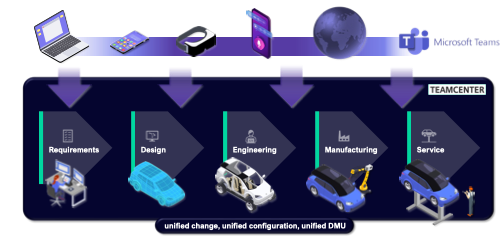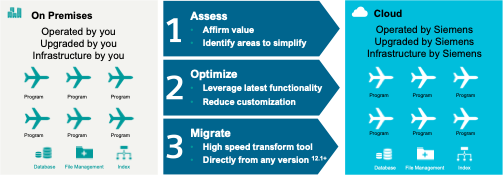Key Takeaways
- Siemens strategic partnerships with IBM, Microsoft, and SAP are delivering significant new value-added capabilities to both Siemens and their partners’ customers:
- IBM Rhapsody integration with Siemens Teamcenter and Capital to enhance Model Based Systems Engineering (MBSE) and early product designs and optimization.
- Integration of Microsoft Teams, Azure Open AI, and Siemens Teamcenter for enhanced distributed collaboration.
- Delivering 100% fidelity between the Teamcenter and SAP Product Configurators―including the concept of usage.
- Siemens is continuing its rapid move to SaaS and cloud delivery of its Xcelerator portfolio and platform.
CIMdata attended Siemens Digital Industries Software (Siemens) Realize Live Americas 2023, held in Las Vegas, NV, on June 12 through 15, 2023.[1] As part of Realize Live, Siemens also conducted its annual Media and Analyst Conference (MAC). Hearing and discussing Siemens announcements, technologies, and solutions with customer attendees, event sponsors, and Siemens’ leadership was exciting and highly informative.
Mr. Tony Hemmelgarn, President and CEO of Siemens Digital Industries Software, kicked off both Realize Live and the MAC. During the MAC session, he provided a financial update stating that the Digital Industries division FY 2023 Q2 profits were up 23% year over year. He noted that in Q2 FY23 the cloud ARR share is approaching 25% driven by a growth rate of 14% during Q2 FY2023. He also stated that 74% of cloud orders are from the Small to Medium Business (SMB) sector. Mr. Hemmelgarn said that the year-over-year contract value for Teamcenter X increased 300%, with significant numbers of customers moving to the SaaS version. For manufacturing, he described how Mendix is enabling companies to create personalized mobile applications and is driving strong growth of Opcenter (13%) with over 105 new customers during the past year.
Mr. Hemmelgarn previewed a new solution (scheduled for release in late 2023) resulting from their strategic partnership with Microsoft, which integrates Microsoft Teams, Azure Open AI, and Siemens Teamcenter (see Figure 1). He noted, for example, that over 70% of in-service product quality issues go unreported because the person who finds the issue has no practical way to communicate it to those responsible for addressing the problem. With the Siemens Teamcenter app on Microsoft Teams, a person will be able to speak in their native language to their mobile device (e.g., phone, tablet, or laptop) and describe the problem. The application will automatically translate the problem description (e.g., from Thai to German) and then use artificial intelligence to investigate possible solutions and automatically create a problem report which is sent to those responsible for resolving the type of problem being reported. The resulting corrective solution is then sent back to the person who reported the problem to implement the corrective solution. Major features include:
- Single Sign On (SSO)―authenticating through Microsoft Teams
- Microsoft Teams as an enterprise portal to Teamcenter
- Azure Open AI to translate the recorded problems
- Azure Open AI automatically extracts key information, creates a problem report in each user’s native language, searches Teamcenter for relevant information to the problem, and identifies and suggests potential solutions
- Teams Apps Services
- To ensure security, all data is stored in Teamcenter, not in the Microsoft Teams backend, and all transmissions are encrypted

Figure 1―Teams as an Enterprise Portal to Teamcenter
(Courtesy of Siemens)
CIMdata believes this exciting combination of Microsoft Teams, Teamcenter, and Azure Open AI will have significant use and benefit for companies in many areas. Siemens and Microsoft stated that this solution will be applied across the Siemens Xcelerator portfolio.
Other interesting items discussed by Mr. Hemmelgarn included:
- Amazon Web Services (AWS) is now selling Mendix
- Siemens is working with AWS to simplify customer access to high-performance computing to provide the computational capacity to execute larger and larger simulations, e.g., computational fluid dynamics (CFD)
- IBM Rhapsody is integrated with Teamcenter and Capital, and IBM Maximo is integrated with Teamcenter
- Both IBM Rhapsody and IBM Maximo are now in the Siemens price book
- Working with NVIDIA, they have created an industrial metaverse capability that is much more than animation. It is built on simulation backed by digital twins and provides dynamic, visual interaction with the product (e.g., cars, boats, planes, facilities) and its environment
- Teamcenter Semiconductor Lifecycle Management is a process-oriented, purpose-built solution for the semiconductor industry
- In the Executive Q&A on day 2, Mr. Hemmelgarn stated that 25% of their ARR last year came from A&D customers, defying conventional wisdom that the A&D industry would be among the last to migrate to PLM on the Cloud
During Mr. Hemmelgarn’s Realize Live keynote, he described the importance of sustainability and how it must be designed into the product up-front. He emphasized Siemens’ commitment to helping companies improve sustainability in their products and operations. This commitment and how Siemens is addressing it was described in more detail in several other Realize Live sessions.
Following Mr. Hemmelgarn, Mr. Puneet Sinha, Sr. Director Battery Industry, and Mr. Nand Kochhar, VP Automotive and Transport Industry, led a session titled “Electrification and Battery Revolution.”[2] In their remarks, they described how Siemens was integrating electronics, electrical, software, and mechanical solutions to address the design and scalable manufacture of batteries to support the future of mobility. They commented that the key trends for automotive and transportation include electrification, autonomous, connected, shared mobility, and sustainability.
Mr. Sinha and Mr. Kochhar noted that Siemens was creating solutions that enabled continuous integration of hardware and software lifecycles for automotive design and electrification, and that the battery was key to electrification. They stated that the Siemens battery solution connects chemistry, electrical, mechanical, and software domains.
Furthermore, they noted that one customer, using their battery solution, has been able to reduce their pack development time by 50%. They followed with the point that simply improving battery development time alone is not sufficient. Companies need to be able to scale up battery production and that requires an integrated concept from plant design through commissioning. Siemens is applying Information Technology and Operational Technology (IT/OT) convergence from factory automation to cloud, enabling an integrated workflow of machine digital twins to PLC code development, validation, and virtual commissioning of the production lines and facilities.
On day 2 of the conference, Mr. Joe Bohman, SVP Teamcenter and Polarion, and Mr. Bill Lewis, Director of Marketing, Lifecycle Collaboration Software, led a session titled “PLM of the Future.” This session was primarily a Teamcenter update, including several demonstrations of new capabilities. Additionally, Mr. Bohman discussed the rapid adoption and growth of Teamcenter X―the SaaS cloud version of Teamcenter. He described Siemens’ three step approach, shown in Figure 2, to helping customers transform to the cloud:
- Assess―tools to identify areas to simplify
- Optimize―leverage latest functionality; do decustomization
- Migrate―utilize a high-speed transformation tool, take data from any Teamcenter version and put it in the cloud

Figure 2―Siemens Approach to Helping Customers Transform to the Cloud
(Courtesy of Siemens)
Mr. Bohman stated that moving to Teamcenter’s Active Workspace user interface is an important first step and noted that they are “all in on Active Workspace.” Working with input from their user community, the latest release includes:
- Session controls
- Page-level tool bar―specific to what you are doing now
- Layout manager to organize the UX to each user’s preferences
- Card styling
- Direct field editing in tree view tables
He stated that the above improvements resulted in a 33% reduction in clicks over previous versions.
Mr. Bohman also described several Teamcenter X solutions (new in BOLD) including:
- Semiconductor Lifecycle Management
- Consumer Packaged Goods Solution
- PLM for Component Manufacturers
- Capital Asset Lifecycle Management
- PLM for Medical Devices, now with an out of the box Design History File (DHF)
- PLM for Machine Builders
- Test and Verification Management
- Integrated Program and Lifecycle Management
Siemens has continued to evolve and improve their Unified BOM and configurator solutions and Mr. Bohman stated that the Unified EBOM is a single system. It now includes the concept of “usage,” which is important when considering different production facilities and integration with ERP. CIMdata believes incorporating usage into the EBOM is a major step forward in overall BOM lifecycle management. The multi-domain unified EBOM forms an integral part of the full digital thread backbone supported by Siemens Xcelerator.
Mr. Bohman said that the Teamcenter Product Configurator does not just incorporate mechanical, electronics, and software. It now also supports simulation and service BOMs (SBOMs). Their multi-domain EBOM solution can now model all domain information together, keeping it aligned with design and enabling it to scale. Mr. Bohman announced that as part of their SAP partnership the two companies have now achieved perfect fidelity between the Teamcenter Product Configurator and the SAP Product Configurator―a capability that CIMdata believes will deliver significant value to their joint customers.
Mr. Bohman and Mr. Lewis also explained the importance and the goals of the Siemens-IBM partnership including integration of IBM’s Rhapsody fully supporting ideation through design lifecycle development phases via the Teamcenter-managed PLM data backbone. Mr. Sky Matthews, CTO IBM ELM division, confirmed this during a joint presentation with Mr. Hans-Juergen Mantsch, Siemens Director E/E Architecture and MBSE. These gentlemen reinforced that the two organizations are working on a detailed set of combined solution plans, e.g., Siemens is expanding the integration of Rhapsody within the Xcelerator portfolio and IBM has updated and released a new, improved version of Rhapsody. CIMdata, as well as both Siemens and IBM customers look forward to seeing the results of those plans in the coming years.
Concluding Remarks
Siemens Realize Live and the Media and Analyst Conference showcased Siemens’ solutions and vision. Siemens continues to push the boundaries of PLM and IT/OT integration. Their new and expanded strategic relationships are delivering new capabilities that neither partner could deliver alone, and these new capabilities can provide significant value to each partners’ customers. Siemens Xcelerator has evolved into both a broad, integrated suite of solutions and a platform upon which customers can incorporate non-Siemens technology and applications.
CIMdata believes that Siemens' strategic partnerships, new solutions, and significant updates of current solutions will enable it to maintain its position as a leading provider of business transformation and product lifecycle capabilities for customers across all industries.
[1] Travel and/or other expenses related to this commentary were provided by Siemens Digital Industries Software.
[2] CIMdata is publishing a series of reports delving into Siemens electric vehicle and battery software solution capabilities. The first of that series was published on 31 May 2023 and is titled “Imperatives as Automotive Industry Pivots to Vehicle Electrification”―go to: https://www.cimdata.com/en/resources/complimentary-reports-research/white-papers







